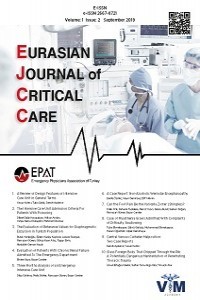The Effect of “Tris-Hydroxymethyl Aminomethane” Treatment on Survival of Rats with Experimental Metabolic Acidosis Created by Intragastric Administration of Hydrochloric Acid
The Effect of “Tris-Hydroxymethyl Aminomethane” Treatment on Survival of Rats with Experimental Metabolic Acidosis Created by Intragastric Administration of Hydrochloric Acid
Metabolic acidosis, , tris–hydroxymethyl aminomethane, sodium bicarbonate,
___
- 1. hidroklorik asit uygulanan deneysel rat modelinde intravenöz sodyum bikarbonat tedavisinin sağ kalım üzerine etkisi. Dr. Berrin Kazancı, Uzmanlık Tezi (Dokuz Eylül Hastanesi, Acil Tıp Anabilim Dalı, İzmir, 2009). (Supervisor attending physician: Gürkan ERSOY, MD) (In Turkish).
- 2. Eray O, Eken C, Oktay C, Gelen T, Avcı AB. Comparison of systemic and local effects of nitric acid and hydrochloric acid: an experimental study in a rat model. Turkish Journal of Trauma & Emergency Surgery 2006;12:184-188.
- 3. Kardon E. M. Toxicity, Caustic Ingestions. http://emedicine.medscape.com/article/813772. Accessed at October 11, 2019.
- 4. Yanturali S, Aksay E, Atilla R. Acute myocardial infarction after hydrochloric acid ingestion. Mt Sinai J Med. 2005;72:(6):409-12.
- 5. Seyran BOZKURT (2009), Zehirlenmeler: Salim SATAR (ed.), Acilde Klinik Toksikoloji (Adana Nobel Kitapevi, ISBN 978 605 397 027 9), 555-561. (In Turkish).
- 6. Sutin KM, Fermon C, Streat S, Wiklund L, Wahlander S, Yellin P, et al. Guidelines for the Treatment of Acidaemia with THAM. Drugs 1998;55:91-224.
- 7. Holmdahl MH, Wiklund L, Wetterberg T, Streat S, Wahlander S, Sutin K, Nahas G. The place of THAM in the management of acidemia in clinical practice. Acta Anaesthesiol Scand 2000;44:524–527.
- 8. Bolatkale M, Ersoy G, Yanturali S, Yilmaz O, Can Ç, Acara A, et al. The Comparison of the Effects of “Trometamol; TrisHydroxymethylaminomethane” and “Sodium Bicarbonate” Treatments on Mortality and Survival Time in Experimental Metabolic Acidosis Induced by Methanol Intoxication. Eurasian J Emerg Med. 2018; 17: 22-7.
- 9. Tribonat™ (Tris-hydroxymethyl Aminomethane) (THAM) web site: http://www.felleskatalogen.no/medisin/tribonat-fresenius-kabi-564807. Acessed at September 20, 2019.
- 10. Marfo K, Garala M, Kvetan V, Gasperino J. Use of Tris–hydroxymethyl aminomethane in severe lactic acidosis due to highly active antiretroviral therapy: a case report. Journal of Clinical Pharmacy and Therapeutics 2009;34:119–123.
- 11. G. Richard Bruno, Wallace A. Carter (2011). Caustics. In; Judith E. Tintinalli, Gabor D. Kelen, J. Stephan Stapczynski (eds), Emergency Medicine A Comprehensive Study Guide, (McGraw-Hill, USA); p:1292-1297.
- 12. Kallet RH, Jasmer RM, Luce JM, Lin LH, Marks JD. The treatment of acidosis in acute lung injury with tris-hydroxymethyl aminomethane (THAM). Am J Respir Crit Care Med 2000;161:1149-53.
- 13. Scheiderman R., Rosenkrantz T.S., Knox I., Cramer R. Effects of a continuous infusion of tris hydroxymethyl aminomethane on acidosis, oxygen affinity, and serum osmolality. Biol Neonate 1993;64:287-294.
- 14. Sirieix D., Delayance S., Paris M. Tris-hydorxymethyl aminomethane and sodium bicarbonateto buffer metabolik acidosis in an isolated heart model. Am J Respir Crit Care Med;1997;155:957-963.
- 15. Sun JH, Filley GF, Hord K, Kindig NB, Bartle EJ. Carbicarb: an effective substitude for NaHCO3. Surgery 1987;102:835-839.
- 16. Weinberger T, Castel T, Bar-Joseph N, Laor A, Bursztein S, Ben Haim S. Comparison of sodium bicarbonate, Carbicarb and THAM during cardiopulmonary resuscitation in dogs. Crit Care Med 1998;26:1397-408.
- 17. Fisher RA, Eckhauser ML, Radivoyevitch M. Acid ingestion in an experimental model. Surgery, Gynecology&Obstetrics 1985;161:91-99.
- 18. Kraut JA, Kurtz I. Use of base in the treatment of severe acidemic states. American Journal of Kidney Diseases 2001;38(4):703-727.
- 19. Rehm M., Finsterer U. Treating Intraoperative Hyperchloremic Acidosis with Sodium Bicarbonate or Tris-Hydroxymethyl Aminomethane: A Randomised Prospective Study. Anest Analg 2003;96:1201-8.
- 20. Bjerneroth, Gunnel. Tribonat (registered sign)-A comprehensive summary of its properties. Critical Care Medicine, 1999;27 (5):1009-1013.
- 21. Samir Jaber, Catherine Paugam, Emmanuel Futier, Jean-Yves Lefrant, Sigismond Lasocki, Thomas Lescot et al. Sodium bicarbonate therapy for patients with severe metabolic acidaemia in the intensive care unit www.thelancet.com Published online June 14, 2018 http://dx.doi.org/10.1016/S0140-6736(18)31080-8
- Başlangıç: 2019
- Yayıncı: Acil Tıp Uzmanları Derneği
Vehbi ÖZAYDIN, Alev ECEVİZ, Fatma SARI DOĞAN
A fatal side effect of piperacillin/tazobactam use: a case report.
Murat DUYAN, Serhat GÜNLÜ, Ali SARIDAŞ, Basar CANDER, Yıldızhan SOLAÇ
Vehbi ÖZAYDIN, Gürkan ERSOY, Elvan ÖÇMEN, Hanife ÇİFTÇİOĞLU YILDIZ, Osman YILMAZ, Necati GÖKMEN, Aslı ÇELİK, Kasım ÖZTÜRK
EMPHYSEMATOUS GASTRITIS – A RARE CAUSE OF PORTO-MESENTERIC VENOUS GAS
Murat DUYAN, Serhat GÜNLÜ, Yıldızhan SOLAÇ, Ali SARIDAŞ, Basar CANDER
THE FILES OF PATIENTS WHO WERE DIAGNOSED WITH DRUG INTOXICATION, RESEARCH LABORATORY ANALYSIS
Ali SARIDAŞ, Basar CANDER, Murat DUYAN
Acil serviste trombolitik tedavi alan pulmoner tromboemboli hastaların analizi
Emine EMEKTAR, Seda DAĞAR, Hüseyin UZUNOSMANOĞLU, Yunsur ÇEVİK
Can Caspase 3 Activity Determine Stroke Duration?”
Sibel GAFUROĞULLARI, Yeşim İŞLER, Halil KAYA, Melih YÜKSEL, Zeynep Nazlı SIR, Yasemin NENNİCİOGLU
